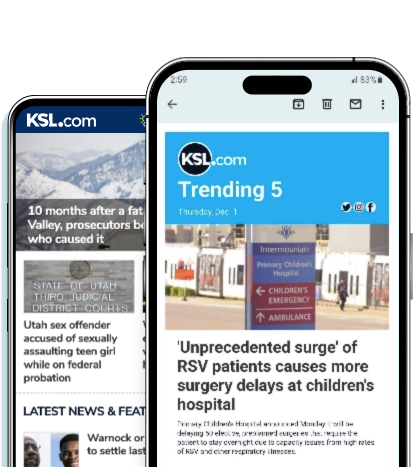Estimated read time: 6-7 minutes
This archived news story is available only for your personal, non-commercial use. Information in the story may be outdated or superseded by additional information. Reading or replaying the story in its archived form does not constitute a republication of the story.
SALT LAKE CITY — The Americans with Disabilities Act was passed by Congress in 1990. Today, this civil rights law contains some areas of exception that come to many as a surprise.
According to its informational website, the ADA “guarantees equal opportunity for individuals with disabilities in public accommodations, employment, transportation, state and local government services, and telecommunications.”
Over the years, numerous organizations have been sued for not meeting all or some portion of ADA compliance guidelines. For instance, according to the law firm Seyfirth Shaw, which runs a website on ADA Title III litigation, the number of lawsuits filed in the U.S. has more than tripled between 2013 and 2018, from 2,722 to 10,163 respectively.
They also reported that in 2015, Utah saw just one lawsuit filed compared to 124 in 2017. Here are some of the most interesting exceptions and issues with ADA compliance that you may not know:
Websites
The web is a prominent place in many people’s lives now, approximately 4 billion people use it. According to the LA Times, increasing numbers of businesses are being sued due to their website not meeting ADA compliance.
According to Title III of the act, all “places of public accommodation” are required by law to remove any “access barriers” that would inhibit a person with disabilities from accessing the business’ goods or services.
While there are guidelines for making a website ADA compliant, called the Web Content Accessibility Guidelines, Dana Barton, director of The Rocky Mountain ADA Center, said there are still no official laws that require a business to apply them to their websites. However, it is important to know that The U.S. Department of Justice has made this statement regarding their stance on website ADA compliance:
"The Department first articulated its interpretation that the ADA applies to public accommodations’ websites over 20 years ago. This interpretation is consistent with the ADA’s title III requirement that the goods, services, privileges, or activities provided by places of public accommodation be equally accessible to people with disabilities."
Equally important, it also noted that “the Department has consistently taken the position that the absence of a specific regulation does not serve as a basis for noncompliance with a statute’s requirements.”
In other words, Barton said, the Department of Justice has declared that regardless of the lack of regulation, websites must comply under Title III of the ADA.
As more of society becomes entwined increasingly digitally-based business, online services like virtual doctors and food delivery services will likely want to put these guidelines into consideration to accommodate people with disabilities ensuring equal access to the Center for Disease Control's reported 1 in 4 U.S. adults who live with a disability.
You can read the full letter written by the department pertaining to the ADA and website compliance here.
Churches
Religious organizations are said to be exempt from having to comply with the ADA, according to a fact sheet from the ADA website. However, they are not completely exempt, Barton said, as they must comply with ADA under Title I for employment if they have at least 15 employees.
Also, "If a private business rents space in a religious entity’s building and operates a day care center that is open to the general public, the day care center will be covered by Title III and subject to all its requirements. The religious entity, however, remains exempt even though it “leases to” a covered business," according to the fact sheet.
It also explains that "if a state or local government offers a program or activity at a religious entity’s facility, like a polling place located at a church, the religious entity is exempt. The state or local government, under Title II, is responsible for compliance with the ADA in relation to that program or activity."
According to The Church of Jesus Christ of Latter-day Saints Newsroom, church materials like hymns and scriptures are available in a variety of formats and the church “strives to make its buildings and facilities accessible to people with disabilities.”
Regardless of religious organizations being exempt from having to comply with the ADA, The American Association of People with Disabilities has published a handbook called “That all may worship,” which is a guide for churches of all faiths to make their facilities accessible and open to people with disabilities.
Apartments
Many people may not know that the ADA does not have any connection with housing. The ADA is just one of several disability laws, and is separate from what is called The Fair Housing Act, which requires that landlords "allow tenants with disabilities to make reasonable access-related modifications to their private living space, as well as to common use spaces."
According to the U.S. Department of Justice's Guide to Disability Rights Laws, The Fair Housing Act "requires landlords to allow tenants with disabilities to make reasonable access-related modifications to their private living space, as well as to common use spaces. (The landlord is not required to pay for the changes.)"
It is also noted that "The Act further requires that new multifamily housing with four or more units be designed and built to allow access for persons with disabilities. This includes accessible common use areas, doors that are wide enough for wheelchairs, kitchens and bathrooms that allow a person using a wheelchair to maneuver, and other adaptable features within the units."
Utilizing more Universal design tactics can help to create more public facilities that can be accessed regardless of someone’s ability level. Some things that work universally are lever door handles instead of round ones, lower placed light switches and making things like shelves adjustable rather than fixed.
Universal design is being implemented more in newer buildings and websites. One important thing to keep in mind when considering the benefits of implicating universal design is being able to accommodate an aging population as well.
Temporary disabilities
This is where the waters can get murky. The term "disability" is a very broad term, but the ADA's legal definition under title III emphasizes disabilities "that place substantial limitations on an individual's major life activities."
One issue with this is that an "impairment" is not the same as a "disability." If it's a broken bone or a concussion with short-term impact, it does not fall under ADA guidelines.
Although short-term issues don't meet ADA requirements, they do still fall under the Family and Medical Leave Act and can be determined as a "serious health condition." So there are still ways for people with temporary disabilities to get help.
If you are interested in reading more about the current ADA guidelines. https://www.ada.gov/.
Editor's note: This story has been updated to clarify the information on the ADA as it relates to websites, churches and apartments.
Nakisha Rigley is currently a Junior at Weber State University majoring in Public Relations and an intern as a news writer at KSL.com.








